#350 bce
Text
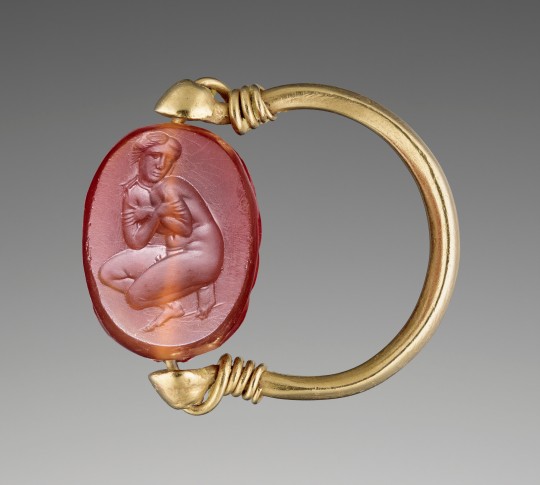

Engraved scarab with Aphrodite bathing in a gold swivel ring
Cornelian and gold, made in Greece or Italy, around 350 BCE
#ring#jewellery#fashion#fashion history#history#aphrodite#swivel ring#ancient greek#ancient greece#italian#350 bce#bce#300s bce#scarab
51 notes
·
View notes
Text

Polychrome terracotta sculpture of the god Dionysos, holding an egg and a rooster. The unusual attributes may hint at a connection to Orphism, which held that the first deity, Phanes or Protogonos ("First-Born"), was hatched from a cosmic egg. Adherents of Orphism saw humankind as the descendants of Dionysos (under the name "Zagreus"), created when the Titans devoured the young Zagreus and were then struck by Zeus' thunderbolt. Artist unknown; created in Tanagra, Boeotia (an important center of terracotta production) ca. 350 BCE. Now in the British Museum.
#classics#tagamemnon#Ancient Greece#Greek religion#Ancient Greek religion#Hellenic polytheism#Dionysus#Dionysos#Orphism#art#art history#ancient art#Greek art#Ancient Greek art#Classical Greece#Classical Greek art#Boeotia#Boeotian art#sculpture#terracotta#British Museum
521 notes
·
View notes
Text
ladies, if your man is:
attributed to the clusium group
dated to the classical period ca. 350-325 BCE
made of terracotta with red figure painting
has an accession number of 19.192.14
thats not your man, thats terracotta duck-askos (flask with spout and handle)

2K notes
·
View notes
Text
Gold Turtle Necklace from Ancient Colchis (modern-day Georgia/South Caucasus) c. 450 BCE: this necklace was crafted from 31 turtle-shaped pendants, each one made of g0ld

The necklace was discovered during excavations at a site known as Vani, in Georgia (the country, not the state). Ancient Vani once served as the religious and administrative center for the Kingdom of Colchis; as I've previously discussed, Colchis was also known as the homeland of the fabled Golden Fleece, and to much of the ancient world, the Colchians themselves were renowned for their skills in goldsmithing.
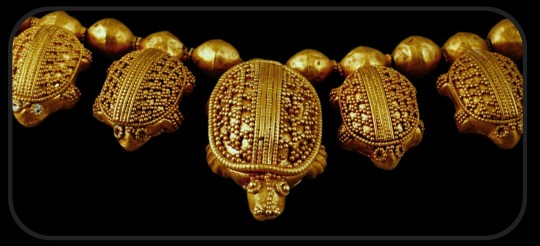
The turtle pendants on this necklace are all decorated with ornate filigree and granulation patterns. The eyes of the 30 smaller turtles were originally made with glass inlay, while the eyes of the largest turtle (seen in the center) were made from drops of gold.
As this article also notes (translated from Georgian):
[This necklace] is unique because of the zoomorphic depiction that it presents. Among the known examples of goldsmithing from antiquity, the depiction of a turtle is not attested anywhere other than the Vani necklace.
The local origin of the necklace is primarily indicated by the stylistic unity of the pendants with other examples of Colchian goldsmithing. It should be noted that the land turtle depicted on the pendants was widespread in Colchis.
The excavations at Vani have uncovered lots of other artifacts made by Colchian goldsmiths. These artifacts include temple ornaments, zoomorphic figures, pieces of jewelry, diadems, headdresses, hairpins, drinking vessels, and appliqués, among other things, and they've provided some really valuable insights into the unique goldsmithing traditions that existed among the peoples of Colchis -- and the myths that evolved as a result.
A few of the other golden artifacts from Vani:
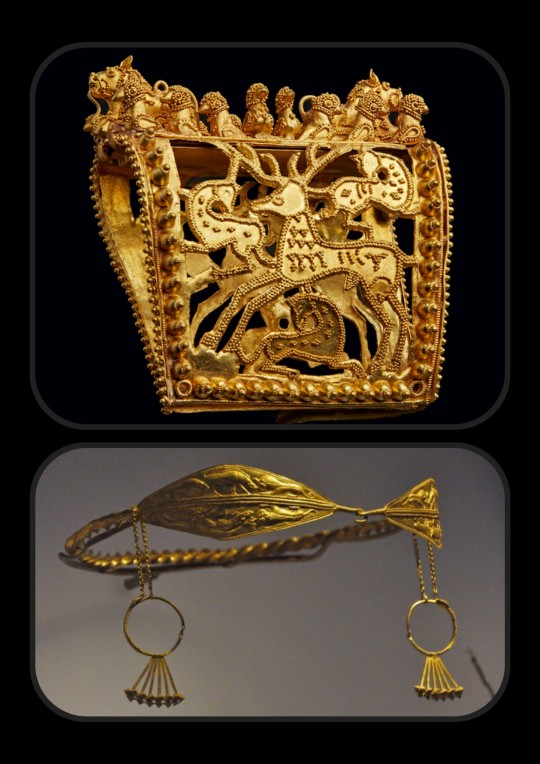
Top: headdress ornament featuring an openwork design, c. 350-300 BCE; the central panel of this piece depicts a stag and three other deer, while the frame is topped by two lions and several rows of birds; Bottom: a diadem with a set of temple ornaments, c. 400-350 BCE; all of the panels along the front of the diadem depict scenes of prey animals being hunted by lions
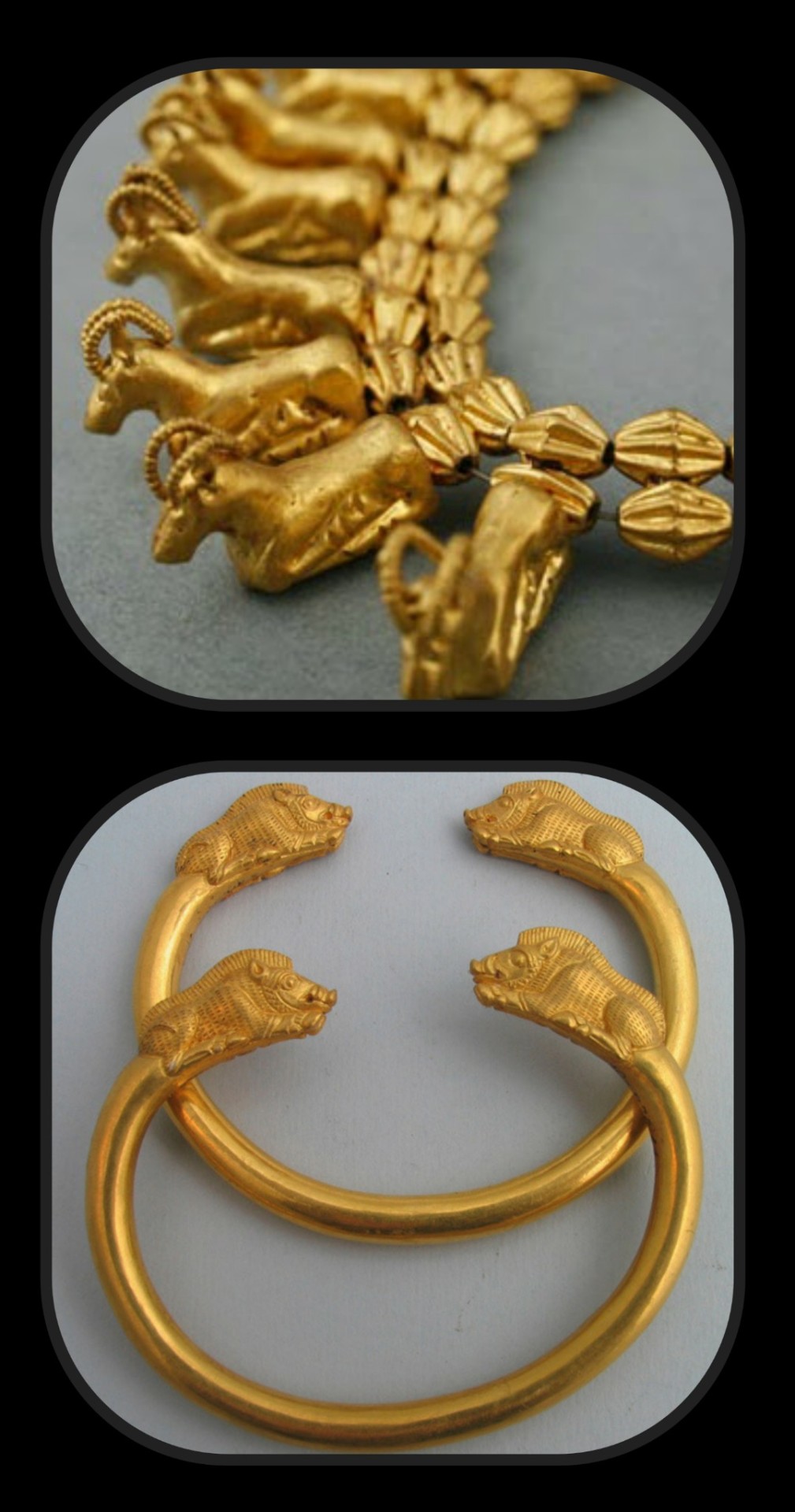
Top: necklace with a series of ram-shaped pendants, c. 400-350 BCE; each pendant was forged from two separate castings that were sealed together to form a complete shape, and the ears/horns were then soldered onto each piece; Bottom: set of bracelets with boar finials, c. 460-440 BCE

Golden appliqués depicting various animals, c. 400-300 BCE

Set of temple ornaments that depict two pairs of riders on horseback, c. 400-350 BCE
And a map showing the location of modern-day Georgia (just for reference):

As this map illustrates, Georgia is nestled right at the crossroads between Europe and Asia, with the Black Sea located on one side and the Caspian not far from the other; it is bordered by Russia to the North and by Turkey, Armenia, and Azerbaijan to the South
Sources & More Info:
National Geographic (Georgian): Golden Kolkheti
Atinati: The Golden Kingdom of Colchis
Smithsonian: Summary of "Wine, Worship, and Sacrifice: the Golden Graves of Ancient Vani" Exhibition
Burusi (Georgian): The Archaeological Discoveries at Vani
Quaternary International: A Modern Field Investigation of the Mythical “Gold Sands” of Ancient Colchis and the “Golden Fleece” Phenomena
#archaeology#history#artifact#ancient history#georgia#sakartvelo#colchis#kolkheti#vani#gold#turtle#jewelry#golden fleece#goldsmithing#south caucasus#mythology#art#applique
2K notes
·
View notes
Text

Gnathian kantaros
* 350-270 BCE
* Medelhavsmuseet, Stockholm
Stockholm, November 2023
#Gnathia#cup#4th century BCE#3rd century BCE#Apulia#ancient#art#chariot#horse#animals#Medelhavsmuseet#Stockholm#my photo
188 notes
·
View notes
Text


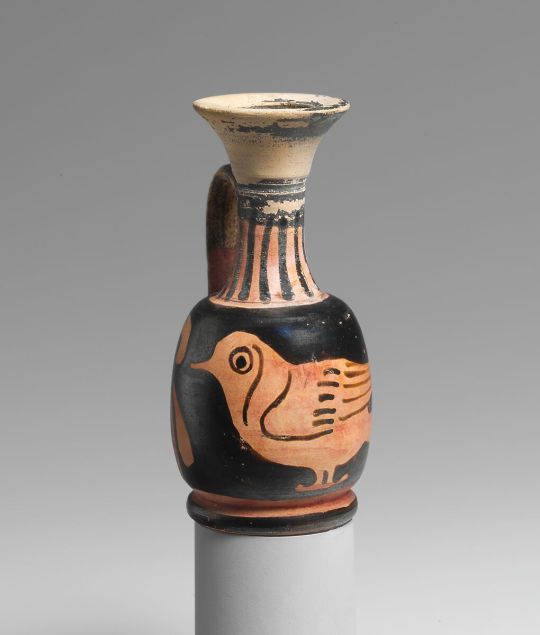
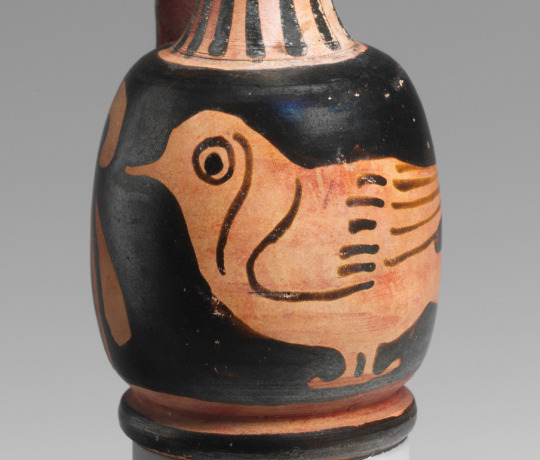
Terracotta skyphos (deep drinking cup), Apulian, ca. 350–325 BCE.
Terracotta lekythos (oil flask) with a bird, Apulian 4th century BCE
793 notes
·
View notes
Text
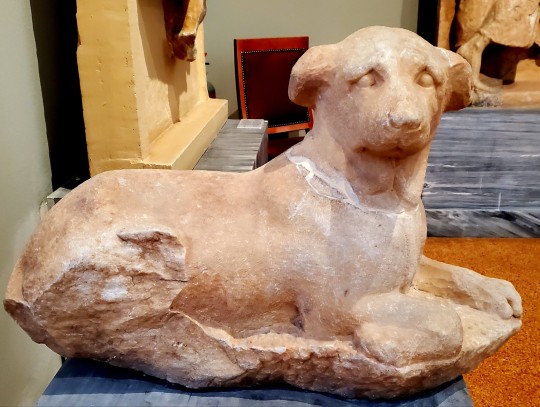
Funerary Statue of a Dog, Pentelic marble, Piraeus (Athens, Greece), c. 375-350 BCE
currently in the collection of the National Archaeological Museum (Athens, Greece), accession no. 3574
this statue is often interpreted as the faithful guardian of the deceased human entombed below him
#archaeology#art#classical archaeology#isaac.jpg#greek#hellenistic#piraeus#funerary archaeology#funerary art#animal figures
544 notes
·
View notes
Text
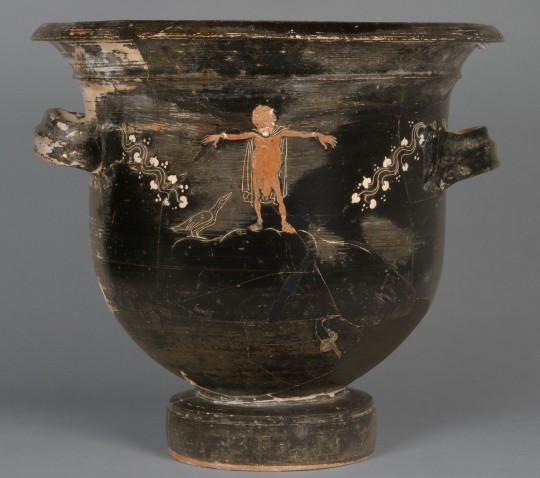
Shamelessly stealing this from mr archaeostoryteller on insta because i had to show you guys this krater from south Italy ( 360-350 bce)

It's Prometheus
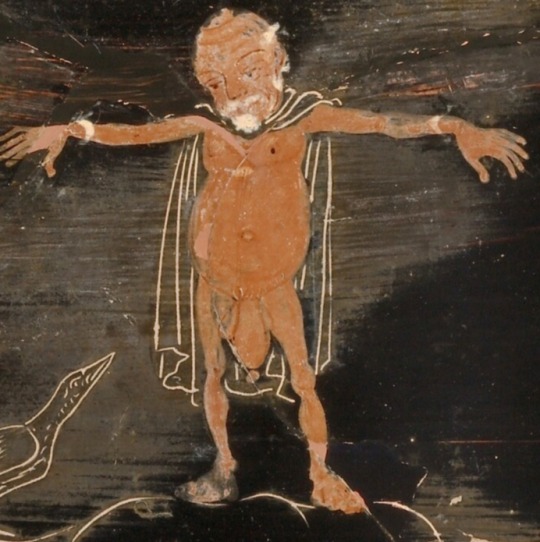
It's meant to be comical and it is but please look at those cartoony legs. They are perfect. They are straight out of asterix or something, the knees and calves and ankles? So good.
123 notes
·
View notes
Text
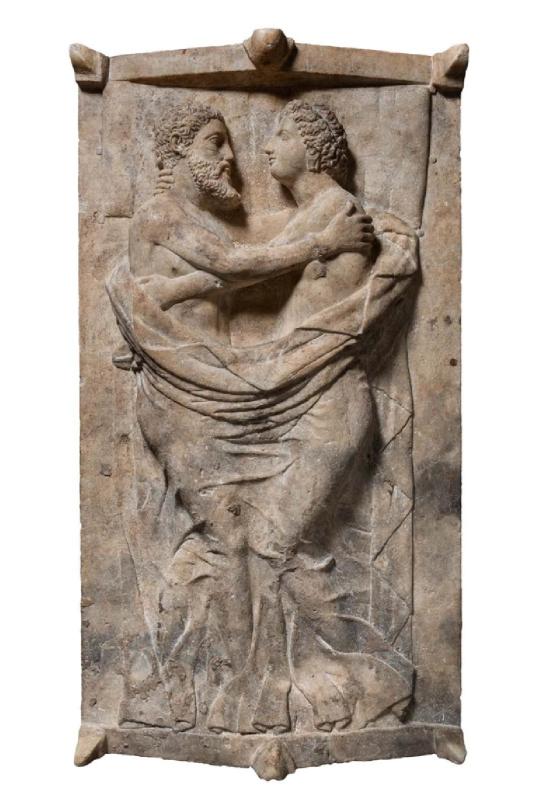
Etruscan (from Vulci, Lazio, Italy), Sarcophagus Lid with a Husband and Wife, ca. 350-300 BCE, travertine (Museum of Fine Arts, Boston)
702 notes
·
View notes
Text


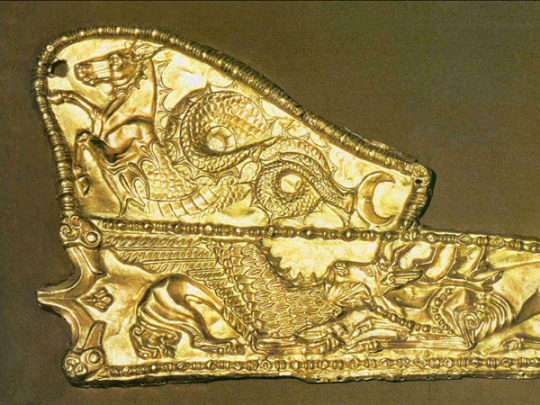
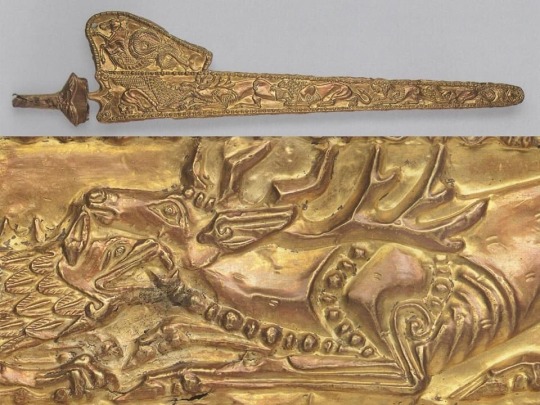
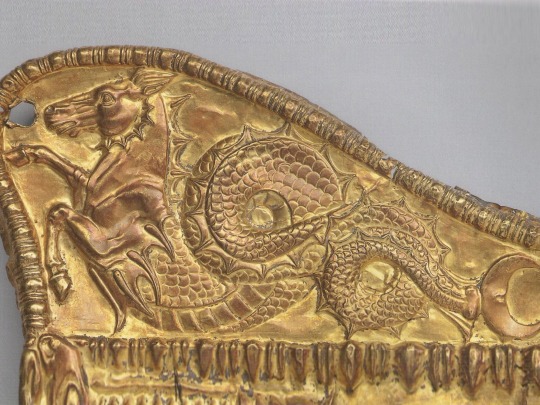
Scythian sword scabbard with hippocampus, griffin, and animals 4th C. BCE. Here is the figure caption from the Hermitage: Overlay for a sword scabbard, Created Scythian culture, 350 - 325 BCE. Place of finding: Dnieper region near Nikopol.
#scythian#scythian gold#scythian mythology#sword#scabbard#art#ancient art#ancient#pagan#paganism#antiquities#museums#artifacts#4th century bce
751 notes
·
View notes
Text
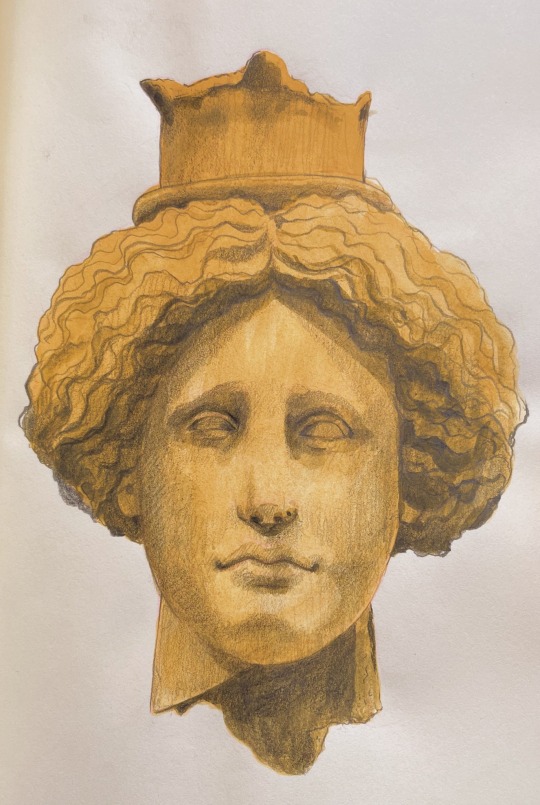
Terracotta Head of a Woman, Sicily, 350-300 BCE
#sketchbook#art#illustration#painting#gouache#acryla gouache#pencil#sketch#ancient greece#Ancient Greek art#greek artifacts
84 notes
·
View notes
Text

Fragment from an Apulian red-figure volute-krater, depicting a woman's head (gorgoneion?) in relief. Artist unknown; ca. 350-320 BCE. Now in the Museum der Universität Tübingen, Germany. Photo credit: ArchaiOptix/Wikimedia Commons.
#classics#tagamemnon#art#art history#ancient art#Apulia#Apulian art#South Italy#South Italian art#vase painting#krater#fragment#red-figure#relief sculpture#gorgoneion#Classical Period#Museum der Universität Tübingen
261 notes
·
View notes
Text
🚨 TOP TEN ANCIENT MEDITERRANEAN (Hellenic) POTTERY SHAPES (and their best in show) 🚨
A lot of these are going to be from Athens. This isn’t because Athens is the best polis at pottery, but because most of the surviving material culture from Greek antiquity was found in Athens. This is just the facts of classics, deal with it.
10. The Oinochoe ⭐️⭐️
This is just a pitcher. A boring boring pitcher used to pour wine. It could have been so much more. where’s the flare? I have nothing left to say.
Best in show: Wtf is he doin with that hog? Wheelbarrow racing? Just kidding, this is actually Herakles defeating that boar and bringing it to Athena. which is cool but its still just a fucking pitcher. (~510 BCE Athens)

9. The Alabastron ⭐️⭐️⭐️
It’s a little vial/jug that holds oils and perfumes. BORING. Do more, be better. Alabastra are the type of vase that wouldn’t stand a chance in a fist fight. I need a bad bitch piece of pottery and this shit isn't cutting it.
Best in show: This Etruscan alabastron. She’s cute! I too like to paint little cats. (620-590 BCE, Corinth)
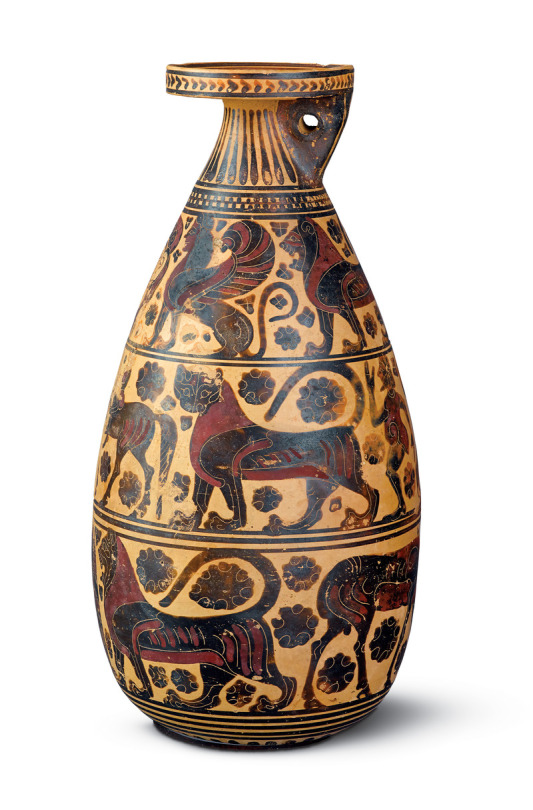
8. The Amphora ⭐️⭐️⭐️
She’s tried and true. She’s a classic. She’s basic as hell. Amphorai have many uses but mainly they’re just glorified modern kitchen Pyrex. They just contain shit. Grains? ✔️ Oil? ✔️ Human Ashes? ✔️ Multipurpose icon, but it’s also the only pottery type with its own emoji 🏺 so she’s too mainstream for my taste. All my homies appreciate the amphora, but it’s never gonna be top 5.
Best in show: Exekias’ pot of mythic warriors Achilles and Ajax playing a lil game. How fun! I love a game night. (~540 BCE Athens)
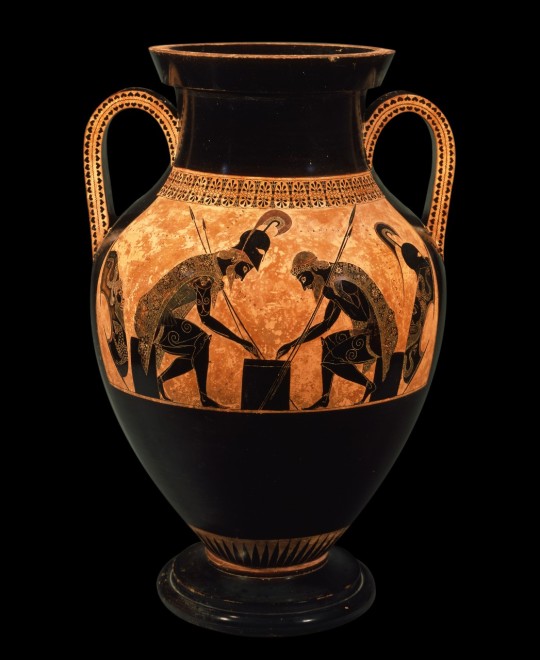
7. The Stamnos ⭐️⭐️⭐️.5
The amphora’s cooler cousin. stamnoi are bad bitches all around. They’re stouter and are made to hold liquids like water and wine (and sometimes as diluting vessels.) They have the same powerful vibe as amphorai but they’re more underground, you’ve probably never heard of them before.
Best in show: Listen. Is she a little flawed? Yes. Is she serving cunt? Kinda. This stamnos depicts Dionysus and his maenads and satyrs! Rad as hell. (370–360 BCE Etruscan)
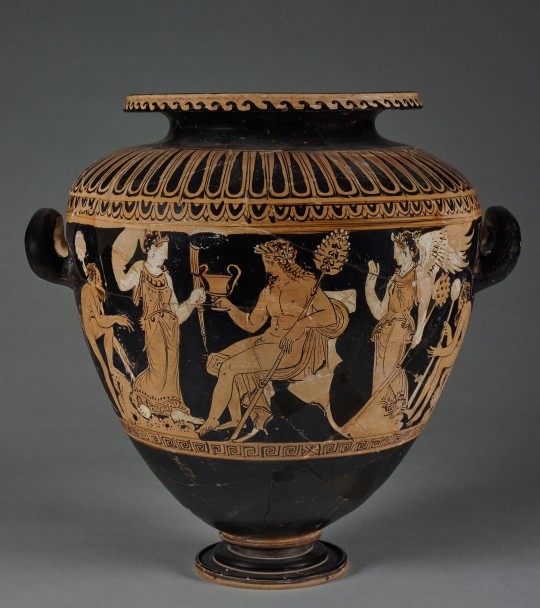
6. The Volute Krater ⭐️⭐️⭐️.5
Kraters are wine mixing pots where water is added to super concentrated wines to make them actually drinkable. Kraters have many different styles but the best of them is the Volute Krater - just like a normal krater, but with fancier handles. They’ve got a very classic look I think, I’d want to hang out with one they seem like they have really expensive and classy tastes. The sugar mommy of ancient pottery.
Best in show: What a pretty mother fucker. (~320 BCE Etruscan).

5. The Lebes Gamikos ⭐️⭐️⭐️⭐️
So... This one is really weird looking and also really pretty. Has maybe the least practical lid I’ve ever seen but who can even blame it when it looks that pretty? A lebes would have been used as a cooking pot. A COOKING POT. CAN YOU IMAGINE WHIPPING THIS BITCH OUT TO MAKE MAC AND CHEESE????
Best in show: TO COOK WITH??????????? It’s got Eros on it and a smaller decorative lebes as the handle. So extra and for what? (350 - 325 BCE Apulia.)

4. The Loutrophorus ⭐️⭐️⭐️⭐️.5
These guys are tall and skinny and potters liked to go ham on the handles. They were ceremonial vases that held water. They’re just really impressive. I mean just look at it. Potters and Painters got to go crazy on these things because they were only really used for big and important rituals and events so they could be as fancy and special as they wanted.
Best in show: I mean,,,, come on folks. This piece has the head of a woman on the lid and each side is decorated with tons of gods and goddesses. It is ornate, it was expensive, it is a fucking queen. (330 BCE)
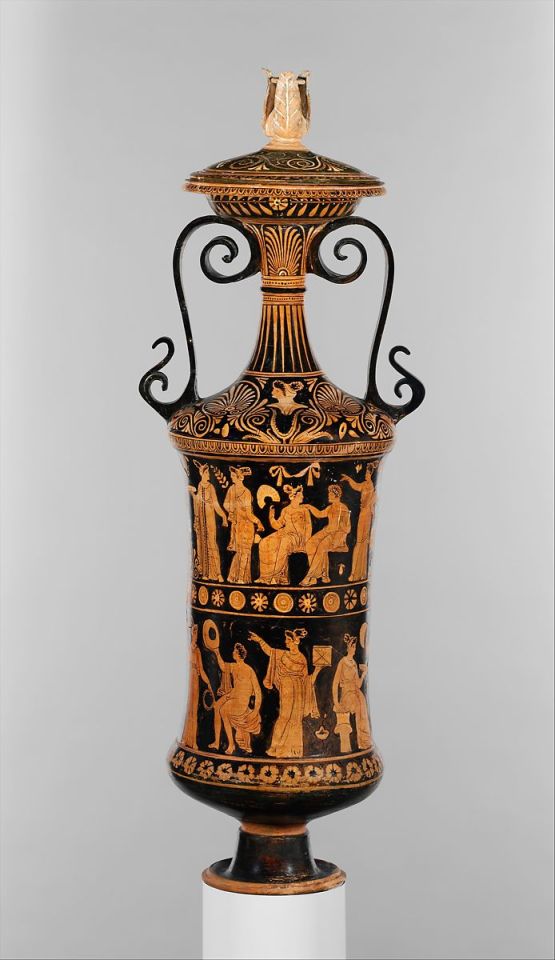

3. The Kylix ⭐️⭐️⭐️⭐️.5
Perhaps a little over rated but definitely not as overhyped as the amphora, the kylix is a wide shallow pot used for sippin’ on drinks in super style. They have painted eyes and when you drink from them the eyes become part of your face and the handles look like ears. This is life changing information. These bitches are big and dramatic, much like me. They were really popular in Mycenean Greece (before the dark ages that birthed the classical Hellenic period we all know and love -- the ancient Greece of ancient Greece) which just screams Scorpio energy; how mysterious and cool of them. These baddies have art not just on the outside, but the inside too!
Best in show: Reminds me of that crazy look anime characters get when they’re about to go off the rails (~510 BCE Athens.) a second less cool kylix is also pictured to show you what they would look like when you drank from them. Hilarious.


2. The Pyxis ⭐️⭐️⭐️⭐️⭐️
Pyxides are the unsung hero of ancient pottery. Most pottery charts will not feature them. But Pyxides are a girl’s best friend.
The pyxis serves as a little jewelry box, a little box for all your trinkets, a little makeup kit. This is the fun type of versatility (👀🏺 get good amphora) These little guys sit on your ancient vanity and open up from the top with a fun shaped handle. Because they were made for women we get a lot of cool insights on women’s lives (and a lot of wedding stuff) in antiquity from these little guys!
Best in show: THIS pyxis depicting a bride preparing for her wedding. Outside she takes a little bath with Eros (winged god of love who later becomes our modern Cupid) and inside he sits on her lap. Talk about a wing man! (~410 BCE Athens.)


1. The Kantharos ⭐️⭐️⭐️⭐️⭐️
If you don’t think a kantharos could steal your girl you’re wrong. These bitches have everything you could ever look for. They’re smaller drinking cups that were most likely used for rituals due to how crazy ornate most of them are. Some of them are even molded to look like heads, that is simultaneously really badass and also very unserious!!
Best(s) in show: A classic ornate kantharos with silver plating depicting the death of Orpheus and the kidnapping of Helen. Look at how fucking GORGEOUS it is (~415 BC.) And a head kantharos (also called a janiform kantharos as they have two faces!) of a satyr and a woman. Imagine drinking from this I would feel so powerful (420 B.C. Athens.)

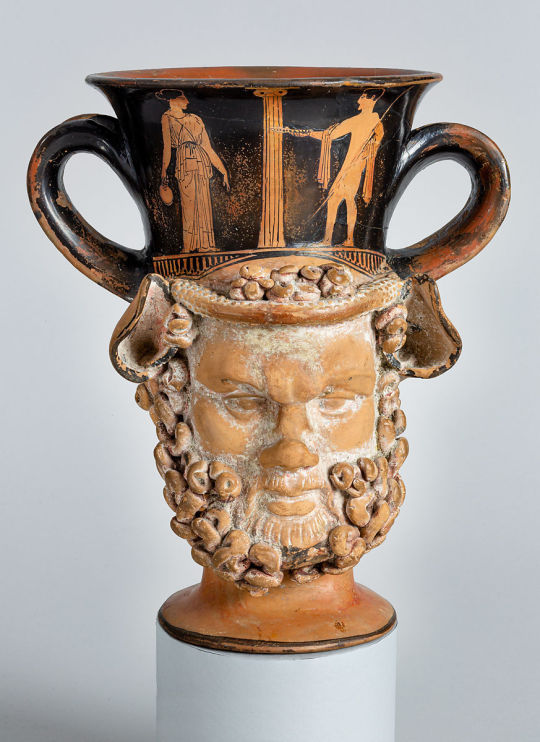

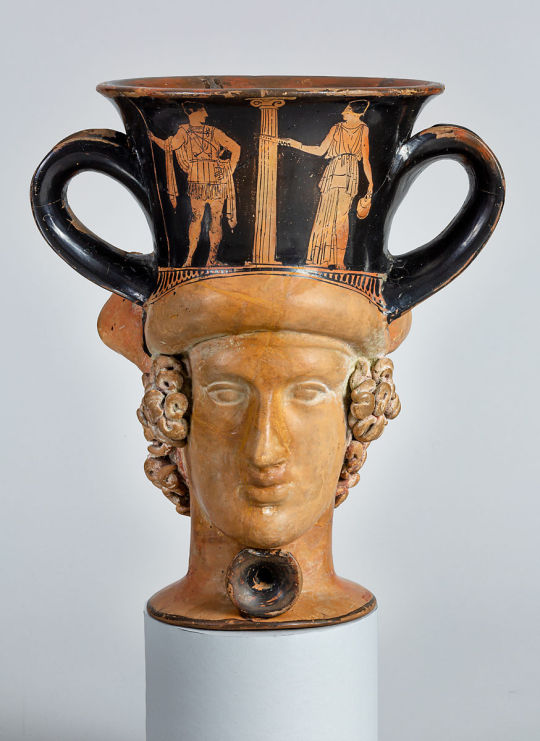
540 notes
·
View notes
Text
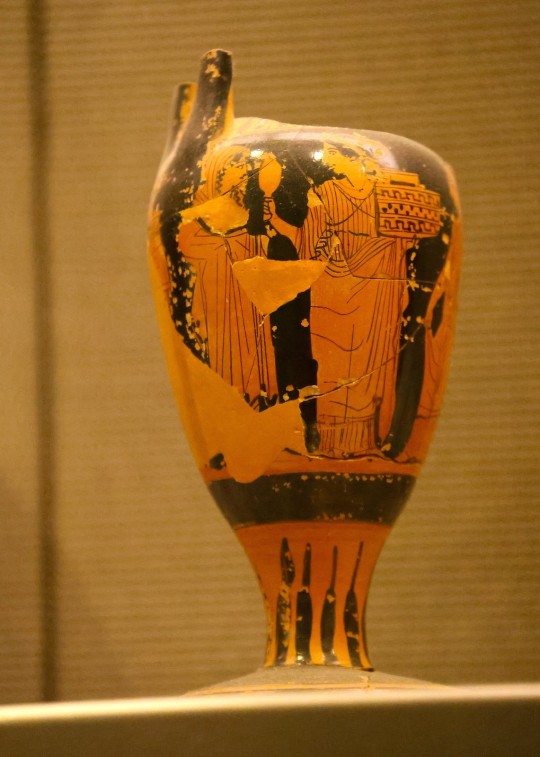
Woman (holding a treasure chest?) admiring herself in a mirror, detail of the attic red-figure hydria (c. 350 BCE)
Collection of Acropolis Museum, Athens, Greece
46 notes
·
View notes
Text
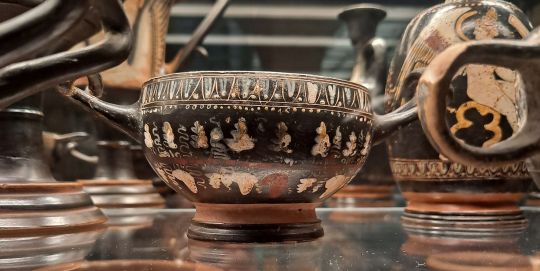
Gnathian "coffee cup"
c. 350-275 BCE
Medelhavsmuseet, Stockholm
Stockholm, November 2023
#Gnathia#4th century BCE#3rd century BCE#ancient#cup#tableware#art#terracotta#Medelhavsmuseet#Swedish Museums#my photo
78 notes
·
View notes
Photo
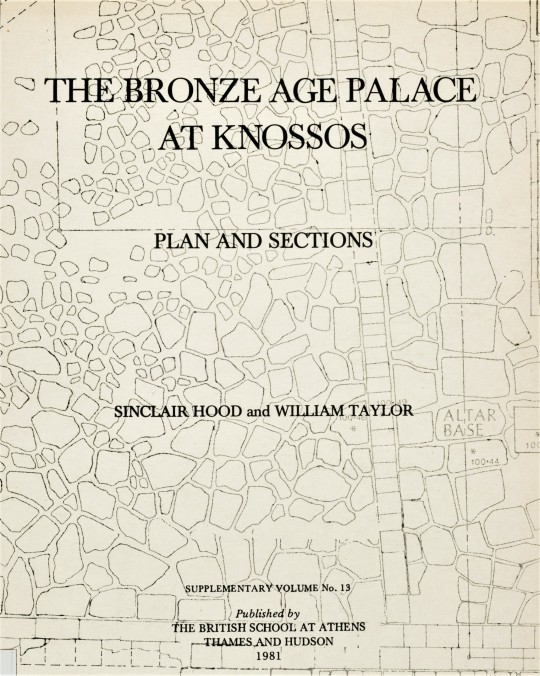
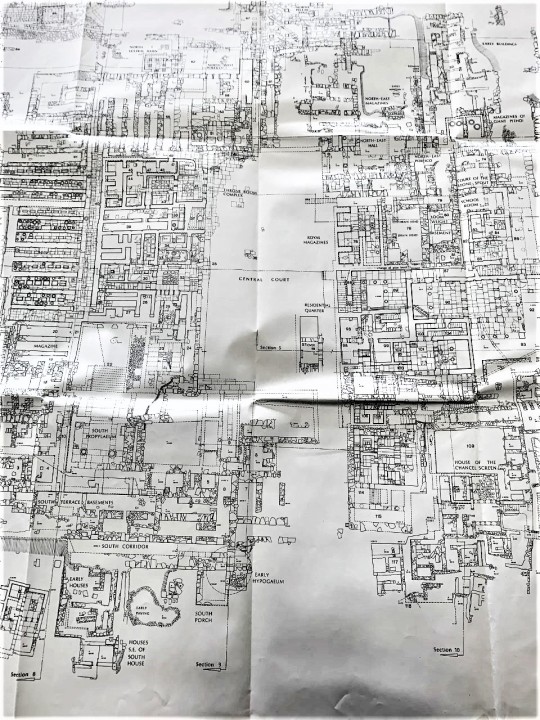
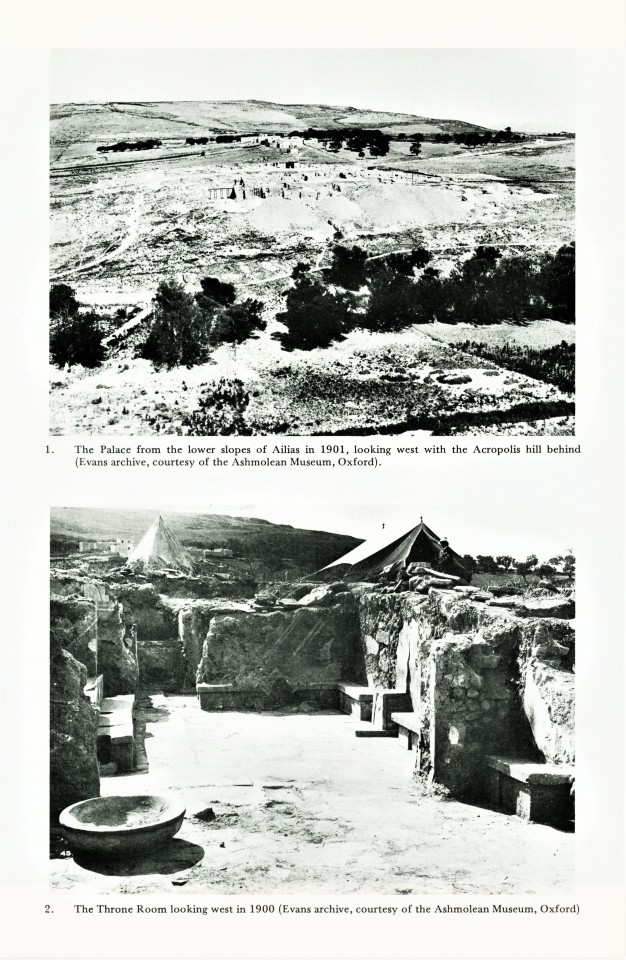





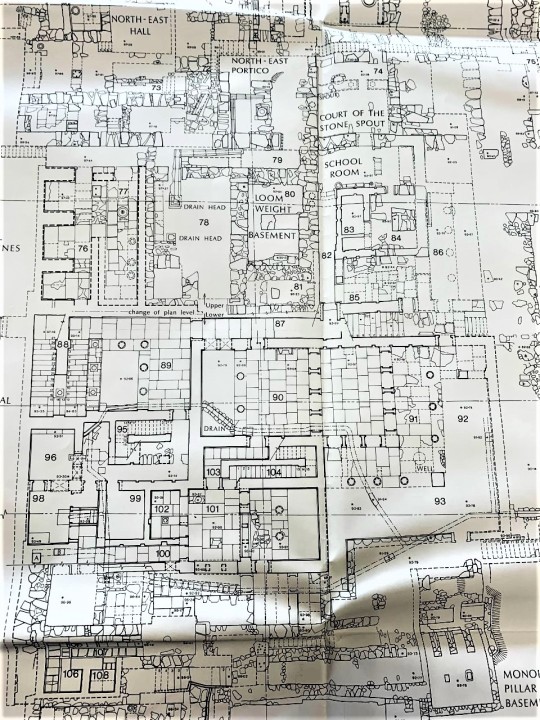
The Minotaur in the Labyrinth
The Minotaur in the Labyrinth stands as one of the ancient stories that has survived the test of time and continuously appears in mainstream entertainment. Most understand that this concept began with the story of Theseus of ancient Athens and how he navigated the labyrinth and slayed the beast within, but many don’t know the inspiration of this idea.
Nearly a millennia before Classical Greece rose to the height of its power (500-350 BCE) the two leading cultures of the Aegean Sea were the Mycenaeans on the mainland and the Minoans on modern day Crete, and it is on this island that we find the labyrinthian structures of Bronze age Greece.
The Bronze Age Palace at Knossos: Plan and Sections by British archaeologist Sinclair Hood and Canadian archaeologist William E, Taylor, Jr., was published as Supplementary Volume No. 13 of The British School at Athens in 1981. It shows the archaeological remains of one of the many Minoan Palaces. Though mostly destroyed and crumbling, we can still see the complex layout of halls and rooms that twist, turn, and abruptly end. Beginning with the excavations of Sir Arthur Evans in 1900, scores of theories have been raised about the purpose of such confounding architecture, from a form of defense to a means of controlling foreign visits.
Besides the confusing architecture, though no depictions of minotaurs were found, Minoan Palaces such as the one at Knossos did contained several pieces of art that depicted bulls. Upon further inspection, the symbol of the Bull was quite prominent throughout the ancient culture from sports, such as bull leaping, to religious sacrifice.
When looking to those who lived in the past, one should remember that we are not the only ones who inquired about archaeological remains. These ruins would’ve been seen by the Classical Greeks, but by that time their imaginations about the great Palaces and Bull iconography of the Minoan civilization was transformed into the myth of the Minotaur in the Labyrinth.
View more posts on Ancient Greece.
-- LauraJean, Special Collections Undergraduate Classics Intern
#Ancient Greece#Minotaur#labyrinth#Minoans#Knossos#The Bronze Age Palace at Knossos#bronze age#Palace at Knossos#archaeology#Sinclair Hood#William E Taylor Jr.#British School at Athens#greek mythology#Crete#LauraJean
318 notes
·
View notes